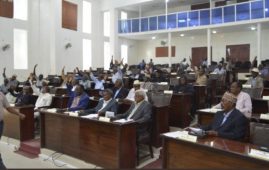Ethiopia’s announcement of the decision to build the Renaissance Dam on the Abay River, the Blue Nile, was met with unprecedented popular support in Ethiopia though, as might be expected, it also caused some worry in Egypt and Sudan. To encourage a spirit of cooperation between the three countries and demonstrate how the construction of the dam will benefit all, Ethiopia has made a number of efforts to reassure those concerned. It delayed ratification of the Nile Basin Cooperative Framework Agreement till the election of Egypt’s new government. It also called for dialogue on the construction of the dam ignoring any hawkish statements from Egyptian academics and politicians. Thirdly, and most strikingly, Prime Minister Meles on a visit to Cairo agreed to the establishment of a joint tripartite technical committee of experts to study the possible effects of the dam on Sudan and Egypt. Given Ethiopia’s decision to build the dam on its own and exercise its right as a riparian country to use the river’s waters, this was a reassuring move. It also underlined Ethiopia’s commitment to the principle of reasonable and equitable utilization of the river. The construction of dam will be of great benefit in reducing water lost through evaporation, preventing siltation and offering the potential of providing energy to Egypt and Sudan.
It should be added that the technical tripartite committee will also be able to play a role in expanding the rapprochement between Ethiopia, Egypt and Sudan. Its activities will provide opportunities for greater cooperation within the rapidly evolving political terrain in Egypt and also in Sudan. The results of the committee’s report will certainly have political as well as technical significance, and will be able to contribute to easing tensions among the riparian states. The Nile Tripartite Technical Committee is to have two experts from each of the three countries involved, together with another four foreign experts. Its mandate is to assess the possible effects of the construction of the Grand Millennium Renaissance Dam on the downstream countries. The committee is expected to submit its independent report within six to nine months and it began in January by setting out the criteria for the choice of foreign experts.
There can be no doubt that the committee will be able to play a significant role in clearing up the doubts and imagined threats that the downstream countries fear as a result of the dam’s construction. The fact that the committee includes experts of all three countries gives it a rare opportunity to objectively assess the impact the dam will have. Ethiopian studies have already made it clear that the dam will have no detrimental effect on the interests of downstream countries. It has also the benefits the dam will offer in terms of controlling downstream flooding and the export of renewable energy.
These views are also supported by a number of Egyptian hydrologists. A study by hydrologist Hytam Awad from the University of Alexandria has demonstrated that during the flood season, August and early September, most of the Nile water arrives in Lake Nasser where it is stored for approximately ten months until the peak agricultural season in July the following year. During this period, approximately twelve percent of the stored water will evaporate. If the water is stored by the Renaissance Dam in Ethiopia there will be significantly less evaporation, and at least half of this amount will be saved. The fact that the dam will be used for hydroelectric power generation also mitigates any fear that it will lessen the flow.
In spite of this research on the subject, a number of Egyptian politicians and academics still remain wary of the project. This is where the composition of the Committee will play a role. One of the benefits of its work towards greater cooperation arises from its composition and mandate. With experts from all three countries it will have a vital role in debunking claims of any minority opinions bent on dismantling the efforts to build trust among member countries. Its report will provide an objectivity that is impossible to deny. It will also offer the chance to create a building block for further coopration.Apart from silencing the hawks in Egypt, it will also offer the new government a strong reason to push on with stronger cooperation between Ethiopia, Egypt and Sudan. Given the Blue Nile supplies around eighty percent of the Nile waters the importance and the value of cooperation is obvious. Egypt’s experience and expertise in hydro-power work offers the chance of closer co-operation between Egypt and Ethiopia. This will have a positive role in conservation of the flow of the Nile which has become increasingly erratic in recent years. Equally, Ethiopia’s export of energy could lead to wider economic integration and bring Egypt and Sudan to the negotiating table on the wider issues of the whole Nile Basin Initiative and the development of the River.
The committee’s report can also be expected to have added benefits with immediate effect on, for example, the issue of the Jonglei canal .The wetlands in South Sudan known as the Sudd is a vast marsh land where a significant volume of the White Nile water is lost. The White Nile enters the Sudd with an average flow rate of 1,048 cu. mts/second and leaves it with an average flow rate of 510 cu.mts/s. Nearly half is lost. The Jonglei Canel Project was initiated by Egypt in 1979. This was the aim to build a 360 km canal to bypass the Sudd but the project was halted during the civil wars. Recently, Egypt has shown some interest in trying to restart the project. Successful cooperation between Egypt and Ethiopia on the Renaissance Dam would lead to greater trust between the riparian countries, particularly South Sudan and the downstream states. It also increases the possibility of translating a possible trade in energy into wider economic integration between the Egypt, Sudan, South Sudan and Ethiopia or even more widely.
There can be no doubt that the Renaissance Dam will have major benefits. In a region where mutual suspicion has long loomed large the composition of the Committee, its mandate and its independence will undoubtedly provide a real opportunity to start afresh on concepts of cooperation and raise it to a greater and more profitable level.
Source: A Week in the Horn – April 06, 2012 issue
*****************
Check the Grand Ethiopian Renaissance Dam archive for related post.






1 Comment on this post
Comments are closed.
Leave a Comment